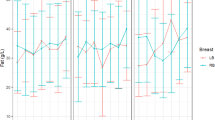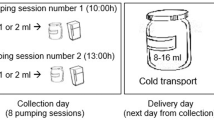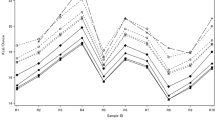Abstract
Objective:
To track individual mother’s macronutrient variability in preterm human milk (HM) over 6 weeks of lactation.
Study Design:
This was a prospective, observational study of mother’s own milk from women who delivered a very low birth weight infant (<1500 g). A single, random maternal breast milk sample was collected and analyzed weekly for 6 consecutive weeks. Analysis was by mid-infrared spectroscopy.
Results:
Twenty women consented to provide at least one milk sample. Fat, protein and energy content varied widely among mothers and by week of lactation. Energy content ranged from 9.5 to 30.4 kcal oz−1 across the study period. Twenty-five percent of all samples had an energy content <17 kcal oz−1. Protein content ranged from 1.1 to 2.8 g dl−1 in the first week. Sixty-three percent of all samples had a protein content <1.5 g dl−1. Fat and energy showed trends of increasing concentrations, whereas protein showed the expected decline over time. Lactose showed little variability by woman or by week of lactation.
Conclusion:
HM fat and protein content varied widely by individual woman over time. Week-to-week variability in fat and protein can impact growth. The ability to analyze HM is helpful to improve fortification of HM.
This is a preview of subscription content, access via your institution
Access options
Subscribe to this journal
Receive 12 print issues and online access
$259.00 per year
only $21.58 per issue
Buy this article
- Purchase on Springer Link
- Instant access to full article PDF
Prices may be subject to local taxes which are calculated during checkout




Similar content being viewed by others
References
Eidelman AI, Schanler RJ for the American Academy of Pediatrics Section on Breastfeeding. Breastfeeding and the use of human milk. Pediatrics 2012; 129 (3): e827–e841.
Ziegler EE . Meeting the nutritional needs of the low-birth-weight infant. Ann Nutr Metab 2011; 58 (Suppl 1): 8–18.
Adamkin DH, Radmacher PG . Fortification of human milk in very low birth weight infants (VLBW <1500 g birth weight). Clin Perinatol 2014; 41 (2): 405–421.
Radmacher PG, Lewis SL, Adamkin DH . Individualizing fortification of human milk using real time human milk analysis. J Neonatal Perinatal Med 2013; 6 (4): 319–323.
Anderson GH, Atkinson SA, Bryan MH . Energy and macronutrient content of human milk during early lactation from mothers giving birth prematurely and at term. Am J Clin Nutr 1981; 34 (2): 258–265.
Bauer J, Gerss J . Longitudinal analysis of macronutrients and minerals in human milk produced by mothers of preterm infants. Clin Nutr 2011; 30 (2): 215–220.
de Halleux V, Rigo J . Variability in human milk composition: benefit of individualized fortification in very-low-birth-weight infants. Am J Clin Nutr 2013; 98 (2): 529s–535s.
Hibberd CM, Brooke OG, Carter ND, Haug M, Harzer G . Variation in the composition of breast milk during the first 5 weeks of lactation: implications for the feeding of preterm infants. Arch Dis Child 1982; 57 (9): 658–662.
Zachariassen G, Fenger-Gron J, Hviid MV, Halken S . The content of macronutrients in milk from mothers of very preterm infants is highly variable. Dan Med J 2013; 60 (6): A4631.
Rochow N, Fusch G, Choi A, Chessell L, Elliott L, McDonald K et al. Target fortification of breast milk with fat, protein, and carbohydrates for preterm infants. J Pediatr 2013; 163 (4): 1001–1007.
Maas YG, Gerritsen J, Hart AA, Hadders-Algra M, Ruijter JM, Tamminga P et al. Development of macronutrient composition of very preterm human milk. Br J Nutr 1998; 80 (1): 35–40.
Stoltz Sjostrom E, Ohlund I, Tornevi A, Domellof M . Intake and macronutrient content of human milk given to extremely preterm infants. J Hum Lact 2014; 30 (4): 442–449.
Wojcik KY, Rechtman DJ, Lee ML, Montoya A, Medo ET . Macronutrient analysis of a nationwide sample of donor breast milk. J Am Diet Assoc 2009; 109 (1): 137–140.
Acknowledgements
The authors would like to thank the mothers who volunteered for this study. We would also like to thank Laura Serke, RD, for helping with the fortification modeling.
Author information
Authors and Affiliations
Corresponding author
Ethics declarations
Competing interests
The authors declare no conflict of interest.
Rights and permissions
About this article
Cite this article
Arnold, M., Adamkin, D. & Radmacher, P. Improving fortification with weekly analysis of human milk for VLBW infants. J Perinatol 37, 194–196 (2017). https://doi.org/10.1038/jp.2016.170
Received:
Revised:
Accepted:
Published:
Issue Date:
DOI: https://doi.org/10.1038/jp.2016.170



